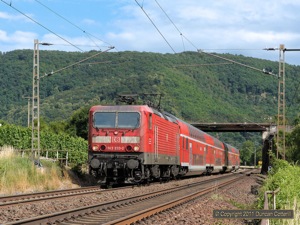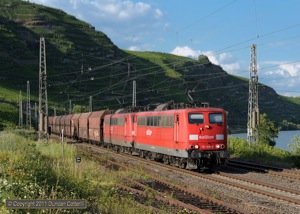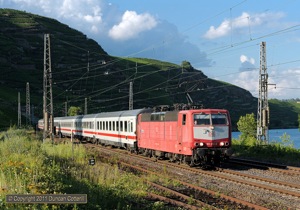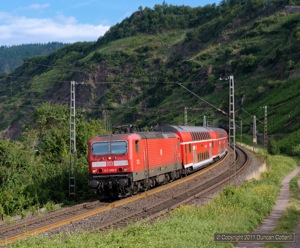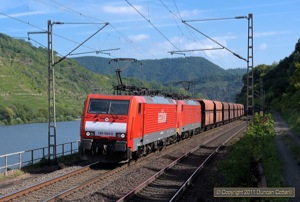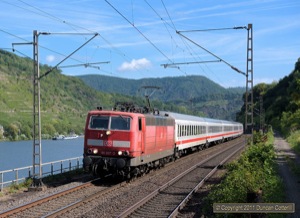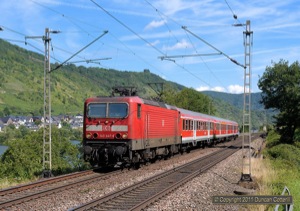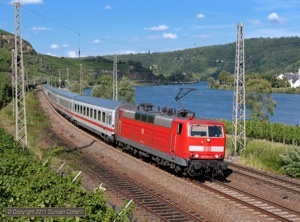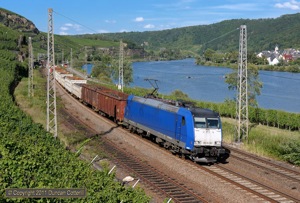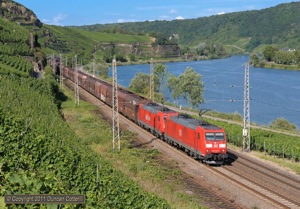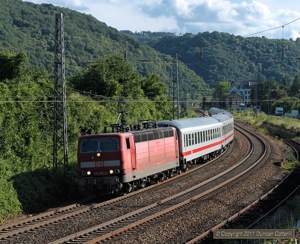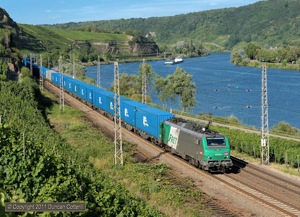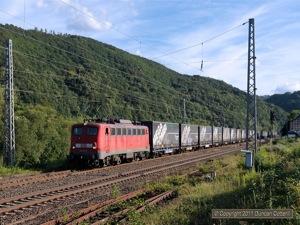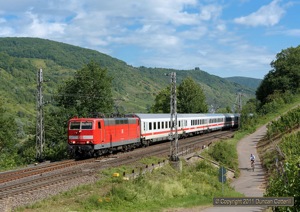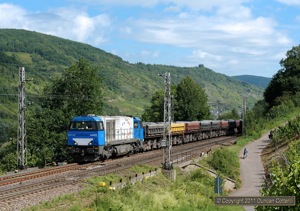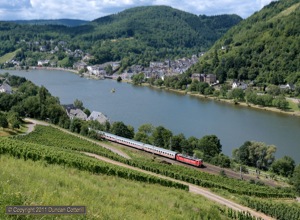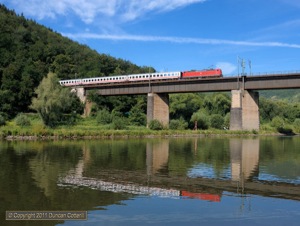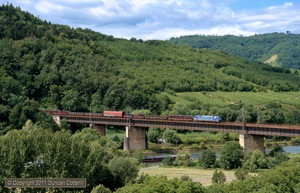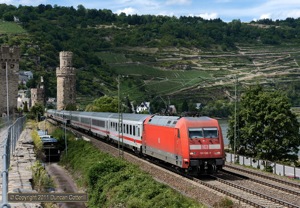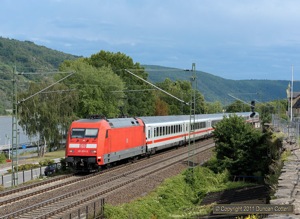Koblenz and the Mosel
06 - 10 July 2011
Report by Duncan Cotterill
Introduction
A short trip to Germany in early July 2011 for five days of lineside photography. I visited the area south of Koblenz where the busy and scenic main-lines that run along the Mosel and Rhein Valleys cut through a hilly area known as the Hunsrück.
After flying to Köln/Bonn, I travelled around by rail and on foot from my base in Koblenz, concentrating on the Mosel Valley.
This section of the report summarises what was seen. For train by train details with loco numbers etc, go to the Day by Day pages.
Line 690 Koblenz – Trier
This scenic, double-track, electrified route runs up the Mosel Gorge for 62 km, from Koblenz to Pünderich, following the river past picturesque villages and the vineyards that cling to the precipitous slopes. The area is most famous for winemaking but its railway is also noteworthy.
The line was built in the late 1870s, after the Franco-Prussian War, mainly to strengthen military links between the German heartland and the newly acquired territories of Alsace and Lorraine. It soon became important as a heavy freight route connecting the industries of Luxembourg, north-eastern France and Saarland with northern Germany, a role it still performs today.
Passenger traffic is also significant with frequent local passenger services and a few InterCity trains. It was the rare dual-system class 181s on the ICs that brought me to the area but I was more than happy to photograph the freights and local passengers as well.
Passenger Services
A service of five pairs of InterCity trains links Luxembourg with Koblenz, via Trier, and a few continue further north, via Köln, to Emden or Norddeich. Between Luxembourg and Koblenz the ICs are hauled by DB class 181 15kV/25kV electrics, a class that’s difficult to find elsewhere.
The local passenger service consists of all-stations RB trains between Koblenz and Trier and Regio Express trains between Koblenz and Saarbrücken. The RBs run hourly. The REs share their hourly path with the IC services, so either an RE or an IC runs every hour but not both.
RE and RB service are worked by a mixture of class 143s and class 425 or 426 EMUs. No doubt there are official diagrams but what turned up appeared to be fairly random during my visit. Most of the REs were worked by locos but the number varied considerably from day to day. The RB service seemed to operate with more locos and fewer EMUs every day until Saturday, by which time the vast majority of trains were loco worked. On Sunday, everything changed and most RB services were worked by EMUs.
The 143s all operated with push-pull sets, usually with the loco coupled to the south end, but several sets had a loco at both ends. In these cases the back engine always had its panto raised and gave every impression of powering. RE services were operated using modern double-deck stock while RB trains were either Silberlingen or older (ex-DR?) double-deckers.
Two special trains were seen. The first, going north on the Wednesday evening consisted of nine Silberlingen and an InterCity bistro hauled by a class 110, the only example of the class I saw. The second, also heading north but this time on the Sunday, was hauled by a pair of ex-SBB class Re4/4i on hideous “Partyzug” stock.
Freight Traffic
Freight traffic was heavy with a total of 91 freights seen during 44 hours at the lineside, or an average of just over one train an hour each way. Every day was busy, even the Sunday when 15 freights were seen in 11 hours. Traffic was quite varied with block trains of coal, iron ore, steel and containers most common. There was plenty of general freight as well and a few other block loads including spoil from the site of the new Kaiser Wilhelm Tunnel, currently under construction between Cochem and Ediger-Eller.
Motive power was also varied with DB locos working the vast majority of trains. Pairs of class 189s worked all the Maasvlakte-Dillingen iron ore trains and a fair number of coal trains, presumably also originating at Dutch ports. The coal trains themselves were formed of standard Fals type hoppers with normal couplings, in contrast to the 12-wheel, auto-coupler fitted hoppers used on the ore trains. Pairs of class 185s were also common on the remaining coal trains, many of which were formed of PKP hoppers, with single locos working many of the intermodals, steel trains and mixed freights. Other classes seen included Class 139, 140, 145, 151 and 152. Only classes 155 and 182 appeared to be absent.
Fret-SNCF class 37000s were nothing like as common as they had been on my previous trip in October 2010. One loco usually appeared on a northbound mixed freight at some time during the day and a southbound container train in the evening would usually produce a class 37000 with ITL logos on otherwise standard Fret-SNCF livery. The other national operator represented was CFL Cargo, with a class 4000 working a handful of trains during my visit.
Private operators locos also appeared in small numbers, mainly classes 185.5 or 186 but CB-Rail class 37500 were also seen.
Two RTS class 272 (G2000) diesels worked spoil trains from the site of the new Kaiser Wilhelm Tunnel works at Ediger-Eller. Loaded trains of air-operated side-tippers would leave Eller every 90 minutes or so and head south to Bullay initially. Most trains continued further south to a dump site in a disused clay pit near Wittlich and returned within a couple of hours.
Around midday two loaded rakes were usually combined at Bullay and taken north by one of the 272s. These trains went beyond Koblenz to dump at another disused clay pit, this time at Wallmerod, north-west of Limburg, a round trip of almost 300km. During the afternoon there was usually a southbound train of empty side tippers hauled by an RTS class 2016 diesel, presumably coming from Wallmerod and heading for the tunnel site. The spoil trains appeared to run as normal on the Saturday but there were no trains from the tunnel site on the Sunday, only a loaded train bound for Wallmerod that must have been stabled at Bullay overnight.
Photography
As with many scenic lines, the route along the Mosel Valley isn’t particularly easy to photograph. It’s difficult to find positions on the sunny side a little way back from the line, with a little height and an unobstructed view. In most places you’re either looking up at the line through trackside weeds or trying to find a gap between rows of six-foot high vines. Getting the river in the shot can also be problematic, unless you take distant shots from the opposite bank.
From the outskirts of Koblenz the line stays on the left (west) bank of the river all the way to Ediger-Eller where it crosses over and immediately dives into the Petersberg Tunnel, emerging at Neef. There were a number of morning positions on next few km to Bullay but the shadows took a long time to clear, even in mid-summer. There were also morning and afternoon positions around the bridges at Ediger-Eller and Bullay.
The Winningen area was also good, particularly around the north end of the station in the early evening.
The weather was very mixed, with long cloudy periods, but there were at least a couple of hours of sunshine every day and sufficient trains to ensure I never had to go back empty handed in the evening. Another blessing when doing a line by train and on foot was the fact it stayed dry until Sunday afternoon. There’s nothing worse than being caught miles from the nearest shelter by a torrential downpour.
Line 471 Koblenz – Mainz – Frankfurt
This is the classic passenger main line down the left (west) bank of the Rhein, which I had last visited in 2002, just before the opening of the Köln – Frankfurt NBS abstracted much of the long distance passenger traffic. However, there are still one or two InterCity or EuroCity trains each way an hour and a loco worked RE service every couple of hours on weekdays.
Most ICs and ECs are worked by DB class 101s but a couple of DB class 120s and an MRCE class 182.5 were also seen. I had expected a lot of push-pull working but only one of the 15 EC/IC trains I saw at Oberwesel on the Friday and Saturday was propelled. The REs I saw were worked by class 143s on push-pull sets but I only saw a couple of trains. The hourly stopping passengers were worked by class 460 Desiro EMUs belonging to Trans Regio and operated under the Mittelrheinbahn banner.
I had expected to see a few freights on the left bank but there were none. This may have been due to signalling problems around St. Goar that were causing delays to most passenger services. It certainly wasn’t due to a lack of freight traffic as the line on the right bank was very busy.
At Boppard, the new depot was full of shiny new class 650 railbuses. No more bunnies, just slugs now.
